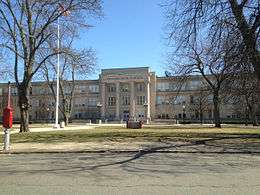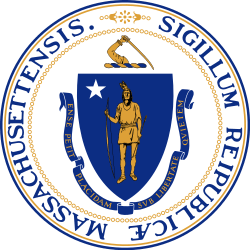Lynn, Massachusetts
Lynn is the 9th largest municipality in Massachusetts[2] and the largest city in Essex County. Situated on the Atlantic Ocean, 3.7 miles (6.0 km) north of the Boston city line at Suffolk Downs, Lynn is part of Greater Boston's urban inner core.[3] Settled by Europeans in 1629, Lynn is the 5th oldest colonial settlement in the Commonwealth.[4] An early industrial center, Lynn was long colloquially referred to as the "City of Sin", owing to its historical reputation for crime and vice. Today, however, the city is known for its contemporary public art,[5][6][7][8] immigrant population, historic architecture, downtown cultural district, loft-style apartments, and public parks and open spaces,[9] which include the oceanfront Lynn Shore Reservation; the 2,200-acre, Frederick Law Olmsted-designed Lynn Woods Reservation; and the High Rock Tower Reservation. Lynn also is home to Lynn Heritage State Park,[10] the southernmost portion of the Essex Coastal Scenic Byway,[11] and the seaside, National Register-listed Diamond Historic District.[12]
Lynn, Massachusetts | |
|---|---|
City | |
 | |
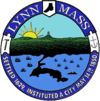 Seal | |
 Location in Essex County and the state of Massachusetts. | |
 Lynn, Massachusetts Location in the United States | |
| Coordinates: 42°28′N 70°57′W | |
| Country | United States |
| State | Massachusetts |
| County | Essex |
| Settled | 1629 |
| Incorporated (Town) | 1629 |
| Incorporated (City) | 1850 |
| Government | |
| • Type | Mayor-council city |
| • Body | Darren Cyr (President, Ward 3) Buzzy Barton (Vice President, at-large) Brian M. Field (at-large) Brian P. LaPierre (at-large) Hong L. Net (at-large) Wayne A. Lozzi (Ward 1) Richard B. Starbard (Ward 2) Richard C. Colucci (Ward 4) Diana Chakoutis (Ward 5) Frederick W. Hogan (Ward 6) John M. Walsh Jr. (Ward 7) |
| • Mayor | Thomas McGee |
| Area | |
| • Total | 13.5 sq mi (34.9 km2) |
| • Land | 10.8 sq mi (28.0 km2) |
| • Water | 2.7 sq mi (6.9 km2) |
| Elevation | 30 ft (9 m) |
| Population (2010) | |
| • Total | 90,329 |
| • Estimate (2019)[1] | 94,299 |
| • Density | 8,583/sq mi (3,314/km2) |
| • Demonym | Lynner |
| Time zone | UTC−5 (Eastern) |
| • Summer (DST) | UTC−4 (Eastern) |
| ZIP Codes | 01901–01905 |
| Area code(s) | 339/781 |
| FIPS code | 25-37490 |
| GNIS feature ID | 0613376 |
| Website | www |
History
17th century
Prior to European colonization, the area today known as Lynn was inhabited by the Naumkeag people.[13] The English settled Lynn not long after the 1607 establishment of Jamestown, Virginia—the first successful English colony in North America—and the 1620 arrival of the Mayflower at Plymouth.[14] European settlement of the area was begun in 1629 by Edmund Ingalls, followed by John Tarbox of Lancashire in 1631.[15] The area today encompassing Lynn was originally incorporated in 1629 as Saugus, the Nipmuck name for the area.[16]
A noteworthy early Lynn colonist, Thomas Halsey, left Lynn to settle the East End of Long Island, where he and several others founded the Town of Southampton, New York. The resulting Halsey House—the oldest extant frame house in New York State (1648)—is now open to the public, under the aegis of the Southampton Colonial Society.[17]
Further European settlement of Lynn led to several independent towns being formed, with Reading created in 1644; Lynnfield in 1782; Saugus in 1815; Swampscott in 1852; and Nahant in 1853. The City of Lynn was incorporated in 1850,[18] taking its name from King's Lynn, Norfolk, England, in honor of Samuel Whiting.[19]
Colonial Lynn was an early center of tannery and shoe-making, which began in 1635. The boots worn by Continental Army soldiers during the Revolutionary War were made in Lynn, and the shoe-making industry drove the city's growth into the early nineteenth century.[19] This legacy is reflected in the city's seal, which features a colonial boot.[20]
19th century

In 1816, a mail stage coach was operating through Lynn. By 1836, 23 stage coaches left the Lynn Hotel for Boston each day. The Eastern Railroad Line between Salem and East Boston opened on August 28, 1838. This was later merged with the Boston and Maine Railroad and called the Eastern Division. In 1847 telegraph wires passed through Lynn, but no telegraph service station was built until 1858.[21]

During the middle of the nineteenth century, estates and beach cottages were constructed along Lynn's shoreline, and the city's Atlantic coastline became a fashionable summer resort.[22] Many of the structures built during this period are today situated within the National Register-listed Diamond Historic District.
Further inland, industrial activity contemporaneously expanded in Lynn. Shoe manufacturers, led by Charles A. Coffin and Silas Abbott Barton, invested in the early electric industry, specifically in 1883 with Elihu Thomson, Edwin J. Houston, and their Thomson-Houston Electric Company.[23] That company merged with Edison Electric Company of Schenectady, New York, forming General Electric in 1892, with the two original GE plants being in Lynn and Schenectady. Coffin served as the first president of General Electric.[24]
Initially the General Electric plant specialized in arc lights, electric motors, and meters. Later it specialized in aircraft electrical systems and components, and aircraft engines were built in Lynn during WWII. That engine plant evolved into the current jet engine plant during WWII because of research contacts at MIT in Cambridge.[25] Gerhard Neumann was a key player in jet engine group at GE in Lynn. The continuous interaction of material science research at MIT and the resulting improvements in jet engine efficiency and power have kept the jet engine plant in Lynn ever since.
One of the largest strikes of the early labor movement began in the shoe factories of Lynn on February 22, 1860, when Lynn shoemakers marched through the streets to their workplaces and handed in their tools, protesting reduced wages.[26] Known as the New England Shoemakers Strike of 1860, it was one of the earliest strikes of its kind in the United States.
In 1841, abolitionist Frederick Douglass, moved to Lynn as a fugitive slave. Douglass wrote his first autobiography, Narrative of the Life of Frederick Douglass, an American Slave, while living in Lynn. The publication would become Douglass' best-known work. Douglass, his wife, and their five children lived in Lynn until 1848.[27]
On February 1, 1866, Mary Baker Eddy experienced the "fall in Lynn", often referred to by Christian Scientists as significant to the birth of their religion.[28]
20th century
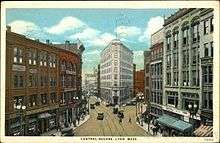
Lynn experienced a wave of immigration during the late 1800s and early 1900s. During the 30 years between 1885 and 1915, Lynn's immigrant population increased from 9,800 to 29,500, representing nearly one-third of the city's total population.[29] Polish and Russian Jews were the largest single group, numbering more than 6,000.[29] The first Jewish settlers in Lynn, a group of twenty Hasidic European families, mostly from Russia, formed the Congregation Anshai Sfard, a Hasidic, conservative Jewish synagogue in 1888.[30] Catholic churches catering to the needs of specific language and ethnic groups also testify to the waves of immigrants. St. Jean Baptiste parish, eventually including a grammar school and high school, was founded in 1886, primarily for French-Canadians. Holy Family Church conducted services in Italian beginning in 1922, and St. Michael's church also provided church services and a grammar school for the Polish-speaking community, beginning in 1906.[31] St. Patrick's church and school was a focus of the Irish-American community in Lynn.[32] St. George's Greek Orthodox Church was founded in Lynn in 1905.[33] Later in the 20th century, the city became an important center of greater Boston's Latino community.[34] Additionally, several thousand Cambodians settled in Lynn between 1975 and 1979 and in the early 1980s.[35]

At the beginning of the 20th century, Lynn was the world-leader in the production of shoes. 234 factories produced more than a million pairs of shoes each day, thanks in part to mechanization of the process by an African-American immigrant named Jan Ernst Matzeliger.[36] From 1924 until 1974, the Lynn Independent Industrial Shoemaking School operated in the city.[37][38] However, production declined throughout the 20th century, and the last shoe factory closed in 1981.[39]
In the early 1900s, the Metropolitan District Commission acquired several coastal properties in Lynn and Nahant, in order to create Lynn Shore and Nahant Beach Reservations, and to construct adjoining Lynn Shore Drive.[40] When it opened to the public in 1910, Lynn Shore Drive catalyzed new development along Lynn's coastline, yielding many of the early 20th century structures that constitute a majority of the contributing resources found in the National Register-listed Diamond Historic District.[18]
During the late 1970s and early 1980s, Lynn suffered several large fires. On November 28, 1981, a devastating inferno engulfed several former shoe factories, located at Broad and Washington Streets. Seventeen downtown buildings were destroyed, with property losses totaling in the tens of millions of dollars. (The affected area has since been largely redeveloped into a satellite campus of North Shore Community College, with many adjacent warehouses converted to loft apartments.)
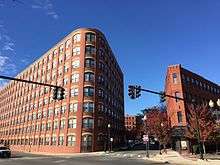
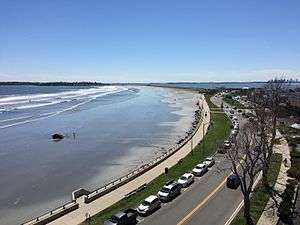
A reputation for crime and vice gave rise to a taunting rhyme about Lynn[41][42] which became popular throughout Eastern Massachusetts: "Lynn, Lynn, the city of sin, you'll never come out the way you went in, what looks like gold is really tin, the girls say 'no' but they'll give in, Lynn, Lynn, the city of sin." Another variation was "Lynn, Lynn the city of sin: if you ain't bad, you can't get in!"
In order to counter its reputation as "the city of sin", Lynn launched a "City Of Firsts" advertising campaign in the early 1990s, which promoted Lynn as having:
- First iron works (1643)[43]
- First fire engine (1654)
- First electric streetcar to operate in Massachusetts[44][43] (November 19, 1888[45][46])
- First American jet engine[43]
- First woman in advertising & mass-marketing – Lydia Pinkham[43]
- First baseball game under artificial light
- First dance academy in the U.S.
- First tannery in the U.S.[47]
- First air mail transport in New England, from Saugus, MA to Lynn, MA.[43]
- First roast beef sandwich.
- First tulip in the United States, at the Fay Estate near Spring Pond
Some of these claims were subsequently found to be inaccurate or unprovable.
In a further effort to rebrand the municipality, city solicitor Michael Barry proposed renaming the city Ocean Park in 1997, but the initiative was unsuccessful.[48]
Despite losing much of its industrial base during the 20th century, Lynn remained home to a division of General Electric Aviation; the West Lynn Creamery (now part of Dean Foods's Garelick Farms unit); C. L. Hauthaway & Sons, a polymer producer; Old Neighborhood Foods, a meat packer; Lynn Manufacturing, a maker of combustion chambers for the oil and gas heating industry; Sterling Machine Co.; and Durkee-Mower, makers of "Marshmallow Fluff".
21st century
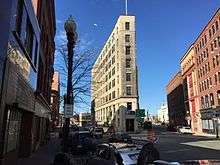
In the early 2000s, the renovation and adaptive re-use of downtown historic structures, together with new construction, launched a revitalization of Lynn, which remains ongoing.[49] Arts, culture, and entertainment have been at the forefront of this revitalization, with new arts organizations, cultural venues, public art projects,[50] and restaurants emerging in the downtown area.[51] In 2012, the Massachusetts Cultural Council named downtown Lynn one of the first state-recognized arts and culture districts in Massachusetts.[52]
In 2015, Massachusetts Governor Charlie Baker established a task force, composed of representatives of multiple state and municipal public agencies, to further Lynn's revitalization.[53]

Formerly vacant industrial buildings continue to be converted into loft spaces,[54] and historic homes, particularly Lynn's Diamond Historic District, are being restored.[55] In 2016, several large land parcels in Lynn were acquired by major developers.[56] In November 2018, construction began on downtown Lynn's first luxury midrise—a 259-unit, 10-story building on Monroe Street.[57][58] in December 2019, ground was broken on a 331-unit waterfront development on Carroll Parkway.[59] Many of the recent and pending large real estate projects in Lynn are Transit-oriented developments, sited within a half-mile of Lynn station, which provides 20-minute train service to North Station.[60]
Lynn's revitalization has been bolstered by the city's emergence as a center of creative placemaking.[61] In 2017, swaths of the city's downtown were transformed by a series of large-scale murals, painted on buildings by local, national, and international artists, as part of the city's inaugural Beyond Walls festival.[50] Light-based interventions, including projections onto High Rock Tower,[62] the installation of vintage neon signs on downtown buildings, and large-scale LED-illuminations of the Massachusetts Bay Transportation Authority rail underpasses bisecting Lynn's Downtown,[63] also have been deployed.[8] In 2017, Mount Vernon Street, in the core of the downtown Central Square area, began to host block parties, food trucks, and other special events.[64][65]
In recent years, Lynn has attracted a substantial and growing LGBT population.[66]
In April 2018, The Boston Globe named Lynn one of the "Top spots to live in Greater Boston in 2018."[67]
Gallery
 General View, 1909
General View, 1909 Market Street, 1911
Market Street, 1911 Newhall House, 1913
Newhall House, 1913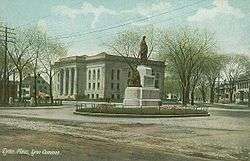 City Hall Square, c. 1906
City Hall Square, c. 1906- Public Library, 2009
 High Rock Tower, c. 1910
High Rock Tower, c. 1910- High Rock Tower, 2006
 Goldfish Pond, 1905
Goldfish Pond, 1905 Lynn Marshes, c. 1905
Lynn Marshes, c. 1905
Geography
According to the United States Census Bureau, the city has a total area of 13.5 square miles (35 km2), of which 10.8 square miles (28 km2) is land and 2.7 square miles (7.0 km2) (19.87%) is water. Lynn is located beside Massachusetts Bay and the Atlantic Ocean. Lynn's shoreline is divided in half by the town of Nahant, which divides Lynn Harbor to the south from Nahant Bay to the north. The city lies north of the Saugus River, and is also home to several brooks, as well as several ponds, the largest being Breed's Pond and Walden Pond (which has no relation to a similarly named pond in Concord). More than one-quarter of the town's land is covered by the Lynn Woods Reservation, which takes up much of the land in the northwestern part of the city. The city is also home to two beaches, Lynn Beach and King's Beach, both of which lie along Nahant Bay, as well as a boat ramp in Lynn Harbor.
Lynn is located in the southern part of Essex County and is 10 miles (16 km) northeast of Boston and 22 miles (35 km) west-southwest of Cape Ann. The city is bordered by Nahant to the south, Swampscott to the east, Salem to the northeast, Peabody to the north, Lynnfield to the northwest, Saugus to the west and Revere (in Suffolk County) to the southeast. Lynn's water rights extend into Nahant Bay and share Lynn Harbor with Nahant. There is no land connection to Revere; the only connection is the General Edwards Bridge across the Saugus River. Besides its downtown district, Lynn is also divided into East Lynn and West Lynn, which are further divided into even smaller areas.
Lynn is loosely segmented into the following neighborhoods:
Central:
- Downtown / Business District
- Central Square
West Lynn:
- Pine Hill
- McDonough Sq./ Barry Park
- Tower Hill / Austin Sq. – Saugus River
- The Commons
- The Brickyard
- Walnut St./Lynnhurst
- Veteran's Village
East Lynn:
- Diamond District / Lynn Shore
- Wyoma Sq.
- The Highlands
- The Fay Estates
- Ward 1 / Lynnfield St.
- Goldfish Pond
- The Meadow / Keaney Park
Climate
Lynn gets cold, snowy winters and warm, humid summers. The other two seasons are mild, in general.
| Climate data for Lynn, Massachusetts | |||||||||||||
|---|---|---|---|---|---|---|---|---|---|---|---|---|---|
| Month | Jan | Feb | Mar | Apr | May | Jun | Jul | Aug | Sep | Oct | Nov | Dec | Year |
| Record high °F (°C) | 71 (22) |
70 (21) |
91 (33) |
94 (34) |
97 (36) |
98 (37) |
104 (40) |
97 (36) |
96 (36) |
84 (29) |
78 (26) |
77 (25) |
104 (40) |
| Average high °F (°C) | 37 (3) |
40 (4) |
47 (8) |
57 (14) |
67 (19) |
76 (24) |
82 (28) |
80 (27) |
73 (23) |
62 (17) |
52 (11) |
42 (6) |
60 (15) |
| Average low °F (°C) | 20 (−7) |
24 (−4) |
32 (0) |
42 (6) |
53 (12) |
63 (17) |
68 (20) |
66 (19) |
58 (14) |
47 (8) |
38 (3) |
28 (−2) |
45 (7) |
| Record low °F (°C) | −9 (−23) |
−5 (−21) |
3 (−16) |
18 (−8) |
32 (0) |
41 (5) |
45 (7) |
44 (7) |
34 (1) |
25 (−4) |
6 (−14) |
−18 (−28) |
−18 (−28) |
| Average precipitation inches (mm) | 3.7 (94) |
2.9 (74) |
4.1 (100) |
4.1 (100) |
4.5 (110) |
3.5 (89) |
4.2 (110) |
4.1 (100) |
4.5 (110) |
3.5 (89) |
4.0 (100) |
3.9 (99) |
47.0 (1,190) |
Demographics
| Historical population | ||
|---|---|---|
| Year | Pop. | ±% |
| 1790 | 2,291 | — |
| 1800 | 2,837 | +23.8% |
| 1810 | 4,087 | +44.1% |
| 1820 | 4,515 | +10.5% |
| 1830 | 6,138 | +35.9% |
| 1840 | 9,367 | +52.6% |
| 1850 | 14,257 | +52.2% |
| 1860 | 19,083 | +33.9% |
| 1870 | 28,233 | +47.9% |
| 1880 | 38,274 | +35.6% |
| 1890 | 55,727 | +45.6% |
| 1900 | 68,513 | +22.9% |
| 1910 | 89,336 | +30.4% |
| 1920 | 99,148 | +11.0% |
| 1930 | 102,320 | +3.2% |
| 1940 | 98,123 | −4.1% |
| 1950 | 99,738 | +1.6% |
| 1960 | 94,478 | −5.3% |
| 1970 | 90,294 | −4.4% |
| 1980 | 78,471 | −13.1% |
| 1990 | 81,245 | +3.5% |
| 2000 | 89,050 | +9.6% |
| 2010 | 90,329 | +1.4% |
| 2019 | 94,299 | +4.4% |
| * = population estimate. Source: United States Census records and Population Estimates Program data.[68][69][70][71][72][73][74][75][76][77][78] Source: | ||
As of the census of 2010, there were 90,329 people, 33,310 households, and 20,988 families residing in the city.[80]
The racial makeup of the city was:
- 57.6% White
- 12.8% African American
- 0.7% Native American
- 7.0% Asian
- 0.1% Pacific Islander
- 16.8% from other races
- 5.0% from two or more races
Hispanic or Latino of any race were 32.1% of the population (10.5% Dominican, 6.3% Guatemalan, 5.4% Puerto Rican, 2.8% Salvadoran, 1.7% Mexican, 0.6% Honduran, 0.4% Colombian, 0.4% Spanish, 0.2% Peruvian, 0.2% Cuban).[80]
Cambodians form the largest Asian origin group in Lynn, with 3.9% of Lynn's total population of Cambodian ancestry. Other large Asian groups are those of Vietnamese (1.0%), Indian (0.4%), Chinese (0.3%), and Laotian (0.2%) ancestry.
In the city, the population was spread out with 24.9% under the age of 18 and 75.1% over 18. Males accounted for 49% and females 51%.[80]
Between 2009 and 2013, the median household income in Lynn was $44,849. The per capita income was $22,982. About 21.0% of the population was considered below the poverty line.[81]
Asian population
In 1990 Lynn had 2,993 persons of Asian origin. In 2000 Lynn had 5,730 Asians, an increase of over 91%, making it one of ten Massachusetts cities with the largest Asian populations. In 2000 the city had 3,050 persons of Cambodian origin, making them the largest Asian subgroup in Lynn. That year the city had 1,112 persons of Vietnamese origin and 353 persons of Indian origin. From 1990 to 2000 the Vietnamese and Indian populations increased by 192% and 264%, respectively.[82]
By 2004 the Cambodian community in Lynn was establishing the Khmer Association of the North Shore.[82]
Income
Data is from the 2009–2013 American Community Survey 5-Year Estimates.[83][84][85]
| Rank | ZIP Code (ZCTA) | Per capita income |
Median household income |
Median family income |
Population | Number of households |
|---|---|---|---|---|---|---|
| Massachusetts | $35,763 | $66,866 | $84,900 | 6,605,058 | 2,530,147 | |
| Essex County | $35,167 | $67,311 | $84,185 | 750,808 | 286,008 | |
| 1 | 01904 | $33,409 | $80,903 | $91,409 | 18,803 | 6,833 |
| United States | $28,155 | $53,046 | $64,719 | 311,536,594 | 115,610,216 | |
| Lynn | $22,982 | $44,849 | $53,557 | 90,788 | 33,122 | |
| 2 | 01901 | $20,625 | $23,467 | $24,125 | 2,023 | 1,096 |
| 3 | 01902 | $20,391 | $37,275 | $45,276 | 44,827 | 16,528 |
| 4 | 01905 | $19,934 | $42,490 | $42,163 | 25,090 | 8,642 |
Arts and culture
Notable locations
- Fraser Field, municipal baseball stadium constructed in the 1940s under the Works Progress Administration. It has housed many minor league baseball teams and a few major league exhibition games for the Boston Red Sox. Currently, it is the home of the North Shore Navigators of the Futures Collegiate Baseball League.
- Manning Field, the municipal football stadium. It is the former site of Manning Bowl (circa 1936 – August 2005).
- Lynn Memorial Auditorium
- Mary Baker Eddy House
- Lucian Newhall House
- Grand Army of the Republic Hall (Lynn, Massachusetts)
- Lynn Museum & Historical Society
- Lynn Community Television
- Capitol Diner
- Lynn Masonic Hall
- St. Stephen's Memorial Episcopal Church
Parks and recreation
Lynn was among the first communities in America to set aside a significant portion of its total land areas for open space—initially to secure a common public wood source. In 1693, Lynn restricted use of areas today encompassed by the Lynn Woods Reservation, and imposed fines for removing young trees. Although this land area was subsequently divided, in 1706, rights of public access were maintained, and, during the 19th century, recreational use of the woods increased.[86]
In 1850, the first hiking club in New England—the Lynn Exploring Circle—was established. In 1881, a group of Lynn residents organized The Trustees of the Free Public Forest to protect Lynn Woods by acquiring land and gifting it to the City.[87] Frederick Law Olmsted was hired as a design consultant for Lynn Woods, in 1889, whereupon he recommended keeping the land wild, adding only limited public access improvements.[86]
Lynn Woods was among the natural resources that inspired landscape architect Charles Eliot and others to create Boston’s Metropolitan Park System. In 1893, Eliot noted that Lynn Woods “constitute the largest and most interesting, because the wildest, public domain in all New England.”[86]
Today, Lynn has 49 parks encompassing 1,540 aggregate acres, representing about 22% of the city's total 6,874-acre land area. Consequently, 96% of all Lynn residents live within a 10-minute walk of a park or open space.[88][89] The city's parks and open spaces include:
- Lynn Shore Reservation
- Lynn Woods Reservation, the largest municipal park in New England, at 2,200 acres (8.9 km2). The bulk of the Reservation's land area is situated in the City of Lynn, but portions fall within the boundaries of adjoining municipalities. Several historical sites such as Stone Tower, Steel Tower, the Wolf Pits, and Dungeon Rock, believed to be the site of still-unrecovered pirate treasure, are located here. Many schools have cross-country track meets in Lynn Woods.
- Lynn Commons, an area between North and South Common Streets.
- Lynn Heritage State Park
- High Rock Tower, a stone observation tower with a view of Nahant, Boston, Downtown Lynn, Egg Rock, and the ocean. The top of the structure houses a telescope, which is open for the public to use.[90]
- Pine Grove Cemetery, an intact rural cemetery, and one of the largest cemeteries in the country. Ripley's Believe It or Not once claimed the fieldstone wall around the cemetery was the "second longest contiguous stone wall in the world", after the Great Wall of China.[91]
- Spring Pond, historic retreat of wild woodlands.
- Goldfish Pond/Lafayette Park
- Community Path of Lynn/Northern Strand, will connect Lynn with the partial finished Bike to the Sea Bike Trail, Revere, Saugus, Malden, and Everett, Massachusetts.[92]
Education
Lynn has three public high schools (Lynn English, Lynn Classical, and Lynn Vocational Technical High School), four middle/junior high schools, two alternative schools, and, as of Autumn 2015, 18 elementary schools.[93] They are served by the Lynn Public Schools district.
KIPP: the Knowledge Is Power Program operates the KIPP Academy Lynn, a 5–8 charter middle school, and a charter high school called KIPP Academy Lynn Collegiate.
There is also an independent Catholic high school located in the city, St. Mary's High School. There are two Catholic primary schools, St. Pius V School and Sacred Heart School. There is also one interdenominational Christian school, North Shore Christian School.[94]
North Shore Community College has a campus in downtown Lynn (with its other campuses located in Danvers and Beverly).
Infrastructure
Transportation
Lynn has no Interstate or controlled-access highways, the nearest being U.S. Route 1 in Saugus and Lynnfield, and the combined Interstate 95 and Route 128 in Lynnfield. (The original design of Interstate 95 called for a route that would have paralleled Route 107 and crossed Lynn - including Lynn Woods - but the project was cancelled in 1972.[95][96]) However, Massachusetts State Route 1A, Route 107, Route 129 and Route 129A all pass through Lynn. Route 107 passes from southwest to northeast along a relatively straight right-of-way through the city. It shares a 0.5 miles (0.80 km) concurrency with Route 129A, which follows Route 129's old route through the city between its parent route and Route 1A. Route 129 passes from the north of the city before turning south and passing through the downtown area and becoming concurrent with Route 1A for 1 mile (1.6 km). Route 1A passes from Revere along the western portion of the Lynnway, a divided highway within the city, before passing further inland into Swampscott. The Lynnway itself runs along the coastline, leading to a rotary, which links the road to Nahant Road and Lynn Shore Drive, which follows the coast into Swampscott.
Lynn has a stop on the Newburyport/Rockport Line of the MBTA Commuter Rail, as well as the River Works stop, which is for GE Aviation employees only. A number of other stations were open until the mid 20th century. Numerous MBTA bus routes also connect Lynn with Boston and the neighboring communities. An extension of the Blue Line to downtown Lynn has been proposed, but not funded. The nearest airport is Boston's Logan International Airport, about 5 miles (8.0 km) south.
In 2014, seasonal commuter ferry service between Lynn and Boston's Financial District was established.[97] A wharf adjacent to the public boat launch ramp located on Blossom Street Extension was rehabilitated, and a 150-space parking lot constructed. Trips to and from Central Wharf in Boston take 35 minutes.[98] After two seasons of operation—and after the federal government allocated $4.5 million for the purchase of a new ferry boat for the line[99]—service was suspended in 2016, when the state declined to continue providing the necessary operating funds.[100] Ferry service resumed in 2017,[101] with a scheduled operating season of June 20 to September 22.[102]
In May 2018, Governor Charlie Baker announced that the Massachusetts Department of Transportation would again suspend funding for the Lynn-Boston ferry.[103]
In November 2019, the Massachusetts Bay Transportation Authority board approved electrifying the commuter rail line serving Lynn and other inner urban core cities, increasing the frequency of service, and reducing fares to subway levels, as part of an "environmental justice corridor" initiative. However, the timeline and cost of these service improvements is not yet clear.[104]
In February 2020, the Massachusetts Bay Transportation Authority announced the commencement of design work to refurbish the Lynn Central Square commuter rail station and adjacent parking garage, with the work being phased so as not to disrupt train service.[105]
Notable people
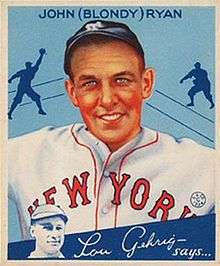
- Corinne Alphen, model and actress
- Julie Archoska, football player
- Verna Bloom, American actress (Animal House, High Plains Drifter, The Last Temptation of Christ)
- Walter Brennan, actor, winner of three Academy Awards, was born in Lynn
- Marion Cowan Burrows, physician and pharmacist, state legislator (1928-1932) representing Lynn
- Frederick Douglass, abolitionist[27]
- Charles Remond Douglass, soldier
- Zari Elmassian, singer, born in Lynn
- Derek Falvey, Major League Baseball executive, was raised in Lynn.
- Neil Hamilton, actor, played "Commissioner Gordon" on TV's Batman
- Frederick Herzberg, psychologist, most famous for introducing job enrichment and the Motivator-Hygiene theory, was born in Lynn
- Ruth Bancroft Law, aviator, was born in Lynn
- Jan Ernst Matzeliger, inventor of shoe-manufacturing equipment, lived in Lynn
- Linda McCarriston, poet, was born and raised in Lynn
- Thomas M. McGee, attorney, State Representative, State Senator, Mayor of Lynn
- Thomas W. McGee, City Councillor, State Representative, Speaker of the Massachusetts House of Representatives
- Ralph McLane, clarinetist
- Ralph Merry, founder of Magog, Quebec, was born in Lynn in 1753.
- Mike Ness, musician, founder of the rock band, Social Distortion. Born in Lynn.
- Alex Newell, actor and singer, notably from the hit TV series Glee
- Jack Noseworthy, actor
- William Dudley Pelley, founder of the Silver Legion of America
- James Durrell Greene, famous inventor and US Civil War Brevet Brigadier General, was born in Lynn
- Ruth Roman, actress, notably from Strangers on a Train, was born in Lynn
- Tom Rowe, professional hockey player
- Harold Shapero, Composer and educator, was born in Lynn
- Todd Smith, pro wrestler
- Susan Stafford, original hostess of Wheel of Fortune
- Lesley Stahl, television journalist, 60 Minutes, was born in Lynn
- Gasper Urban, football player
- Holman K. Wheeler, architect of more than 400 structures in Lynn[106]
- Major League Baseball players Harry Agganis, Stan Andrews, Les Burke, John Deering, Josh Fogg, Bump Hadley, Jim Hegan, Ken Hill, Chris Howard, Mike Pazik, Blondy Ryan and Tom Whelan, all were born in Lynn
In popular culture
- Lynn is mentioned in Stephen King's Cell[107]
- Many versions of the Mother Goose nursery rhyme "Trot, trot to Boston" include Lynn as the second destination.[108]
- Episodes of the TV reality series Cops focused on Boston, including one episode in Lynn.[109][110]
- The movie Black Mass starring Johnny Depp includes:
- the Saint Patrick's Day Parade Scene which was shot on Union Street in Lynn, MA[111] (the Central Square Commuter Rail station entrance was made up to look like the Broadway Red Line station)
- scenes shot in the parking lot of The Porthole Restaurant on the Lynnway[112]
- a scene shot at the former Anthony’s Hawthorne restaurant[113]
- a scene shot under the railroad bridge at Washington Street
- a scene shot at the corner of Union Street and Silsbee Street in which the 270 Union Street building was made up to resemble a Boston Police station[114]
- Scenes from the movie Surrogates, especially the chase scene, were filmed in downtown Lynn.[115] Lynn native Jack Noseworthy starred in the film, and has said he pushes Lynn as a location whenever involved in a project.
- The high school scene in Central Intelligence was filmed at Lynn Classical and Lynn English high schools.[116]
- The movie Joy starring Jennifer Lawrence shot many scenes in Lynn, including the Kmart scene on Boston Street at the old Star Market Location. The final meeting scene took place at the Lynn Item Building at 38 Exchange Street.
- A scene for the movie The Departed was filmed on the Marsh Road in Lynn.
- Freddie Quell, the protagonist from the film The Master, proclaims to be from Lynn.
See also
- List of mill towns in Massachusetts
- Timeline of Lynn, Massachusetts
- National Register of Historic Places listings in Lynn, Massachusetts
- National Register of Historic Places listings in Essex County, Massachusetts
- List of museums in Massachusetts
- Lynn and Boston Street Railway
- Lynn Belt Line Street Railway
- Boston, Revere Beach and Lynn Railroad
- Belden Bly Bridge
References
- "Population and Housing Unit Estimates". Retrieved May 21, 2020.
- "Population and Housing Occupancy Status: 2010 - State -- County Subdivision, 2010 Census Redistricting Data (Public Law 94-171) Summary File". U.S. Census Bureau. Retrieved March 23, 2011.
- . Metropolitan Area Planning Commission. Retrieved on 2016-06-06.
- "Massachusetts City and Town Incorporation and Settlement Dates". Commonwealth of Massachusetts. Retrieved September 18, 2018.
- "Murals enliven downtown Lynn". The Boston Globe. Retrieved May 10, 2018.
- "Let's build Massachusetts by building the arts". The Boston Globe. Retrieved April 1, 2018.
- "IT'S HAPPENING HERE: Public art lifts the Lynn community". Gateways. Retrieved April 1, 2018.
- "Group wants to cast Lynn in a whole new light". The Boston Globe. Retrieved April 1, 2018.
- . Boston Globe. Retrieved on 2016-06-06.
- "Lynn Heritage State Park". Mass.gov. Retrieved May 13, 2018.
- . Essex National Heritage Area. Retrieved on 2016-06-07.
- "Asset Detail". npgallery.nps.gov. Retrieved May 13, 2018.
- Perley, Sidney (January 1, 1912). The Indian Land Titles of Essex County, Massachusetts. Essex Book and Print Club.
- History of Lynn (1829). Retrieved on 2016-03-16
- Tarbox Family Crest and History. Houseofnames.com (December 25, 2012). Retrieved on 2013-09-18.
- Herbert, George. History of Lynn... 1629–1864, 1890.
- "Full text of "Thomas Halsey of Hertfordshire, England, and Southampton, Long Island, 1591-1679 : with his American descendants to the eighth and ninth generations"". archive.org. Retrieved July 4, 2017.
- "Brief History of Lynn". www.cityoflynn.net. Archived from the original on July 7, 2017. Retrieved July 4, 2017.
- Brief History of Lynn Archived August 29, 2012, at the Wayback Machine at City of Lynn website
- City of Lynn official website
- USigs.org Archived March 23, 2004, at the Wayback Machine, History of Lynn Ch2-1814–1864 pub1890.
- "Brief History of Lynn". www.cityoflynn.net. Archived from the original on October 20, 2016. Retrieved October 19, 2016.
- Gifford, Jonathan (September 15, 2013). 100 Great Business Leaders: Of the world’s most admired companies. Marshall Cavendish International Asia Pte Ltd. pp. 34–35. ISBN 9789814484688.
- Amphilsoc.org Archived March 5, 2008, at the Wayback Machine, Elihu Thomson Papers at the American Philosophical Society
- Massmoments.org, MassMoments GE Jet Engine Tests in Lynn
- "Archived copy". Archived from the original on August 16, 2016. Retrieved July 3, 2016.CS1 maint: archived copy as title (link)
- "Re-Examining Frederick Douglass's Time in Lynn". itemlive.org. February 2, 2018. Retrieved February 3, 2018.
- "The Life of Mary Baker Eddy". Marybakereddylibrary.org. December 3, 1910. Retrieved June 5, 2016.
- "The Jewish Heritage Center of the North Shore (Swampscott, Mass.)". jhcns.org. Retrieved July 3, 2016.
- "Guide to the Congregation Anshai Sfard (Lynn, Massachusetts) Records, undated, 1899–2001 [Bulk 1952–2001], I-556". cjh.org. Retrieved July 3, 2016.
- "Archdiocese of Boston Ethnic Parishes". bostoncatholic.org. Retrieved July 3, 2016.
- "Archdiocese of Boston Sacramental Record Inventory – Parishes by City, H-Z". bostoncatholic.org. Retrieved July 3, 2016.
- "St. George Greek Orthodox Church – Our Parish". stgeorgelynn.org. Retrieved July 3, 2016.
- http://scholarworks.umb.edu/cgi/viewcontent.cgi?article=1087&context=gaston_pubs
- "Sanghikaram Wat Khmer – The Pluralism Project". pluralism.org. Retrieved July 3, 2016.
- "Jan Matzeliger". Biography. Retrieved October 23, 2019.
- "MACRIS Details". mhc-macris.net. Retrieved July 3, 2016.
- ":: Merrell Footlab ::". merrellfootlab.com. Retrieved July 3, 2016.
- "How Lynn Became The Shoe Capitol of the World". wgbh.org. May 30, 2014. Retrieved July 3, 2016.
- DCR (April 5, 2013). "Lynn Shore & Nahant Beach Reservation". Energy and Environmental Affairs. Retrieved July 4, 2017.
- Méras, Phyllis (2007). The Historic Shops & Restaurants of Boston. p. 56.
- Kerry, John (November 27, 2007). "Don't Leave New England Families Out in the Cold". United States Senate. Archived from the original on January 6, 2010. Retrieved January 13, 2010.
- "A BRIEF HISTORY OF LYNN". About Lynn. City of Lynn. Retrieved October 19, 2019.
The first Electric Trolley in the state ran from Lynn in 1888
- "Famous Firsts in Massachusetts". History of Massachusetts. Secretary of the Commonwealth of Massachusetts. Retrieved October 20, 2019.
1888 The first electric trolley in the state runs in Lynn.
- The Thomson-Houston Road at Lynn, Mass., The Electrical World, December 8, 1888, page 303
- Electric Railway at Lynn, Mass., Electric Power, January 1889, page 21
- "Famous Firsts in Massachusetts". History of Massachusetts. Secretary of the Commonwealth of Massachusetts. Retrieved October 20, 2019.
1629 The first tannery in the U.S. began operations in Lynn.
- Daley, Beth (March 6, 1997). "Rhyme may be reason to change Lynn's name". Boston Globe. Retrieved January 13, 2010.
- "Lynn's sin label outdated, residents insist – The Boston Globe". BostonGlobe.com. Retrieved June 12, 2016.
- "Murals enliven downtown Lynn". The Boston Globe. Retrieved April 1, 2018.
- "DOWNTOWN LYNN CULTURAL DISTRICT | you won't go out the way you came in". dtlcd.org. Retrieved June 14, 2016.
- "Mass Cultural Council | Services | Cultural Districts". www.massculturalcouncil.org. Retrieved June 14, 2016.
- "Governor launches task force to revive Lynn's fortunes – The Boston Globe". BostonGlobe.com. Retrieved June 9, 2016.
- "Work to resume on Lynn lofts | Itemlive". www.itemlive.com. Archived from the original on June 29, 2016. Retrieved June 9, 2016.
- "Flip This House – Lynn House is Being Renovated for A&E Network Series | Lynn Journal". Retrieved June 9, 2016.
- "Lynn is at the Center of Development,North of Boston | Lynn Journal". Retrieved June 9, 2016.
- "Developers Have Discovered Lynn. What Comes Next?". www.wbur.org. Retrieved December 13, 2019.
- Share; Tweet; Share (November 6, 2018). "Monday marked the groundbreaking of the luxury apartment development on Munroe Street". Itemlive. Retrieved December 13, 2019.
- Share; Tweet; Share (December 12, 2019). "Lynn breaks ground on $100M waterfront development". Itemlive. Retrieved December 13, 2019.
- "Transit Oriented Development Comes To Lynn". News. June 1, 2018. Retrieved December 15, 2019.
- "Beyond Walls meant business - Itemlive". Itemlive. July 24, 2017. Retrieved April 1, 2018.
- "The Lights Will Stay On At Lynn's High Rock Tower Thanks To A Crowdfunding Campaign". Lynn Item. Retrieved August 15, 2018.
- "Beyond Walls Lights Up Downtown Lynn 'Like Times Square On New Year's Eve'". Lynn Item. Retrieved August 15, 2018.
- "What You Need To Know Before Lynn's 'Rock The Block' Celebration - Itemlive". Itemlive. July 21, 2017. Retrieved April 23, 2018.
- "Strong Response To Ironbound's Food Truck Emporium In Lynn - Itemlive". Itemlive. April 22, 2018. Retrieved April 23, 2018.
- 17, Steven A. Rosenberg Globe Staff January; 2013. "Gay meccas in Mass. – The Boston Globe". BostonGlobe.com. Retrieved June 18, 2016.CS1 maint: numeric names: authors list (link)
- "Best places to live in Massachusetts". The Boston Globe. Retrieved May 18, 2018.
- "Total Population (P1), 2010 Census Summary File 1". American FactFinder, All County Subdivisions within Massachusetts. United States Census Bureau. 2010.
- "Massachusetts by Place and County Subdivision - GCT-T1. Population Estimates". United States Census Bureau. Retrieved July 12, 2011.
- "1990 Census of Population, General Population Characteristics: Massachusetts" (PDF). US Census Bureau. December 1990. Table 76: General Characteristics of Persons, Households, and Families: 1990. 1990 CP-1-23. Retrieved July 12, 2011.
- "1980 Census of the Population, Number of Inhabitants: Massachusetts" (PDF). US Census Bureau. December 1981. Table 4. Populations of County Subdivisions: 1960 to 1980. PC80-1-A23. Retrieved July 12, 2011.
- "1950 Census of Population" (PDF). Bureau of the Census. 1952. Section 6, Pages 21-10 and 21-11, Massachusetts Table 6. Population of Counties by Minor Civil Divisions: 1930 to 1950. Retrieved July 12, 2011.
- "1920 Census of Population" (PDF). Bureau of the Census. Number of Inhabitants, by Counties and Minor Civil Divisions. Pages 21-5 through 21-7. Massachusetts Table 2. Population of Counties by Minor Civil Divisions: 1920, 1910, and 1920. Retrieved July 12, 2011.
- "1890 Census of the Population" (PDF). Department of the Interior, Census Office. Pages 179 through 182. Massachusetts Table 5. Population of States and Territories by Minor Civil Divisions: 1880 and 1890. Retrieved July 12, 2011.
- "1870 Census of the Population" (PDF). Department of the Interior, Census Office. 1872. Pages 217 through 220. Table IX. Population of Minor Civil Divisions, &c. Massachusetts. Retrieved July 12, 2011.
- "1860 Census" (PDF). Department of the Interior, Census Office. 1864. Pages 220 through 226. State of Massachusetts Table No. 3. Populations of Cities, Towns, &c. Retrieved July 12, 2011.
- "1850 Census" (PDF). Department of the Interior, Census Office. 1854. Pages 338 through 393. Populations of Cities, Towns, &c. Retrieved July 12, 2011.
- "1950 Census of Population" (PDF). 1: Number of Inhabitants. Bureau of the Census. 1952. Section 6, Pages 21–7 through 21-09, Massachusetts Table 4. Population of Urban Places of 10,000 or more from Earliest Census to 1920. Retrieved July 12, 2011. Cite journal requires
|journal=(help) - "Census of Population and Housing". Census.gov. Retrieved June 4, 2015.
- "Profile of General Population and Housing Characteristics Lynn, MA: 2010". American FactFinder – United States Census Bureau. Archived from the original on February 12, 2020.
- "Lynn (city), Massachusetts Quick Facts". United States Census Bureau. Archived from the original on April 3, 2013.
- Buote, Brenda J, "Asian population up in small cities" (Archive). Boston Globe. June 13, 2004. Retrieved on September 10, 2015.
- "SELECTED ECONOMIC CHARACTERISTICS 2009–2013 American Community Survey 5-Year Estimates". U.S. Census Bureau. Archived from the original on January 17, 2015. Retrieved January 12, 2015.
- "ACS DEMOGRAPHIC AND HOUSING ESTIMATES 2009–2013 American Community Survey 5-Year Estimates". U.S. Census Bureau. Archived from the original on January 5, 2015. Retrieved January 12, 2015.
- "HOUSEHOLDS AND FAMILIES 2009–2013 American Community Survey 5-Year Estimates". U.S. Census Bureau. Archived from the original on February 12, 2020. Retrieved January 12, 2015.
- "Lynn Woods Historic District--MA Conservation: A Discover Our Shared Heritage Travel Itinerary". www.nps.gov. Retrieved November 3, 2018.
- Annual Report of the Park Commissioners of the City of Lynn ... The Commissioners. 1890.
- "ParkServe". ParkServe. The Trust for Public Land. Archived from the original on November 10, 2017. Retrieved November 9, 2017.
- "U.S. Census Bureau Quick Facts". U.S. Census Bureau Quick Facts. U.S. Census Bureau. Retrieved November 9, 2017.
- "High Rock Park, Tower and Observatory". Official Website. Archived from the original on October 4, 2008. Retrieved June 14, 2017.
- Pine Grove Cemetery, archived from the original on July 27, 2011
- "Learn about the Community Path of Lynn". The Boston Globe. Retrieved May 23, 2018.
- Lynn Public Schools. "School Profiles". Archived from the original on August 11, 2007. Retrieved August 2, 2007.
- Massachusetts Department of Education. "Lynn – Directory Information". Retrieved August 2, 2007.
- "The Roads Not Taken". www.architects.org. Archived from the original on August 19, 2017. Retrieved June 14, 2017.
- "Interstate 95-Massachusetts (North of Boston Section)". www.bostonroads.com. Retrieved June 14, 2017.
- "Lynn ferry has ripple effect – The Boston Globe". BostonGlobe.com. Retrieved June 12, 2016.
- "Lynn to Boston Ferry Schedule" (PDF). www.ediclynn.org. Retrieved June 14, 2017.
- "Feds float $4.5 million into Lynn for ferry | Itemlive". www.itemlive.com. Retrieved June 12, 2016.
- "City officials: State sunk ferry | Itemlive". www.itemlive.com. Retrieved June 12, 2016.
- "Lynn to Boston". www.bostonharborcruises.com. Archived from the original on April 30, 2018. Retrieved September 30, 2017.
- "Ferry will float again this summer | Itemlive". www.itemlive.com. Retrieved June 14, 2017.
- "Baker says no to ferry - Itemlive". Itemlive. May 10, 2018. Retrieved May 18, 2018.
- "MBTA Board Commits To Reimagined Commuter Rail System". www.wbur.org. Retrieved December 21, 2019.
- "Design work for renewed Lynn MBTA stop begins in March". www.itemlive.com/. Retrieved December 22, 2019.
- Industries of Massachusetts: Historical and Descriptive Review of Lynn, Lowell, Lawrence, Haverhill, Salem, Beverly, Peabody, Danvers, Gloucester, Newburyport, and Amesbury, and their leading Manufacturers and Merchants. International Publishing Co. 1886. p. 52. Retrieved September 22, 2019.
- King, Stephen. Cell. p. 365.
- Ra, Carol F. (1987). Trot, trot, to Boston: play rhymes for baby. New York: Lothrop, Lee & Shepard Books. ISBN 0688061907.. "Trot, trot, to Boston; Trot, trot, to Lynn; Trot, trot, to Salem; Home, home again."
- "Boston, MA 6". Cops. Episode 108. December 14, 1991.
- "Boston/New City, MA". Cops. Episode 317. November 12, 1996.
- "The movie Black Mass is recreating the St. Patrick's Day Parade in downtown Lynn, MA on Monday, June 23".
- "'Black Mass' Filming at The Porthole Pub in Lynn".
- "'Black Mass', starring Johnny Depp, filming in Lynn, MA on Monday".
- "'Black Mass' takes its sets to Lynn and back to the '70s and '80s".
- LynnCAM TV (October 28, 2008). Hollywood Meets Lynn: The Surrogates. Lynn, Massachusetts: LynnCAM TV. Retrieved November 18, 2017.
- "Lynn High Schools Are Central To Movie". Daily Item. Lynn, MA. June 17, 2016. Retrieved November 18, 2017.
Bibliography
- Lewis, Alonzo and James Robinson Newhall. History of Lynn, Essex County, Massachusetts: Including Lynnfield, Saugus, Swampscott and Nahant. Published 1865 by John L. Shorey 13 Washington St. Lynn.
- Panoramic View of the Hutchinson Family Home on High Rock including all of Lynn, Massachusetts published 1881 by Armstrong and Co, at the LOC website.
- D'Entremont, Jeremy. Egg Rock Lighthouse History. Website.
- Carlson, W. Bernard. Innovation as a Social Process: Elihu Thomson and the Rise of General Electric, 1870–1900 (Cambridge: Cambridge University Press, 1991).
- Woodbury, David O. Elihu Thomson, Beloved Scientist (Boston: Museum of Science, 1944)
- Haney, John L. The Elihu Thomson Collection, American Philosophical Society Yearbook 1944.
- United Press International. "Blaze destroys urban complex in Lynn, Mass." The New York Times, November 29, 1981. Page 28.
External links
| Wikimedia Commons has media related to Lynn, Massachusetts. |
| Wikisource has the text of the 1921 Collier's Encyclopedia article Lynn. |
- City of Lynn official website—includes "Virtual Tours of the Gems of Lynn", a gallery of 360° panoramic photos
